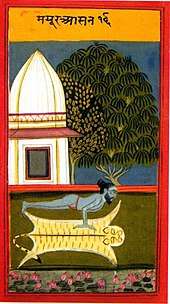Navasana
Navasana, Naukasana, Boat Pose, or Paripurna Navasana (Sanskrit: परिपूर्णनावासन; IAST: paripūrṇanāvāsana "Full Boat Pose") is a seated asana in modern yoga as exercise.[1]

Etymology and origins
The name comes from the Sanskrit words नाव nava meaning "boat" and आसन asana meaning "posture" or "seat".[2][3]
The pose is illustrated in the 19th century Sritattvanidhi under the name Naukāsana, also meaning boat pose.[4]
Description
The body comes into a V-shape, balancing entirely on the buttocks. In different variations and traditions, the arms, legs and torso may take different positions. In Paripurna Navasana, the legs and back are lifted high and arms extend forward and parallel to the ground. In Ardha Navasana, hands interlace behind the neck and both back and shoulders are closer to the ground.
To come into the pose, begin seated on the floor. Bend your knees, bringing the soles of the feet to the ground, and bring the palms to the back of the thighs. Begin to lean back as you shift your weight from your feet, eventually lifting the soles of the feet off the ground. Balance on the sitting bones, not leaning right back on to the tailbone. Lengthen the spine to broaden and lift the chest.[5]
Variations
Variations include the easier Ardha Navasana (Sanskrit: अर्धनावासन "Half Boat Pose") with feet and body only half-raised,[6] and Eka Pada Navasana ("one legged boat pose").
The more difficult Ubhaya Padangusthasana has both hands grasping the toes or feet.[7]
References
- "Yoga Journal - Full Boat Pose". Retrieved 2011-04-09.
- Active Interest Media (1996). Yoga Journal. Active Interest Media. p. 51. ISSN 0191-0965.
- Sinha, S. C. (1996). Dictionary of Philosophy. Anmol Publications. p. 18. ISBN 978-81-7041-293-9.
- Sjoman, N. E. (1999) [1996]. The Yoga Tradition of the Mysore Palace. Abhinav Publications. p. 69. ISBN 81-7017-389-2.
- Pizer, Ann (19 July 2019). "How to Do Boat Pose (Navasana) in Yoga". Very Well Fit.
- "Ardha Navasana (Half Boat Pose)". Retrieved 2011-04-09.
- Halweil, Erika (26 February 2018). "Challenge Pose: Ubhaya Padangusthasana". Yoga Journal.
Further reading
- Iyengar, B. K. S. (1 October 2005). Illustrated Light On Yoga. HarperCollins. ISBN 978-81-7223-606-9. Retrieved 9 April 2011.
- Saraswati, Swami Satyananda (1 August 2003). Asana Pranayama Mudra Bandha. Nesma Books India. ISBN 978-81-86336-14-4. Retrieved 9 April 2011.
- Saraswati, Swami Satyananda (January 2004). A Systematic Course in the Ancient Tantric Techniques of Yoga and Kriya. Nesma Books India. ISBN 978-81-85787-08-4. Retrieved 9 April 2011.
_from_Jogapradipika_1830_(detail).jpg)

